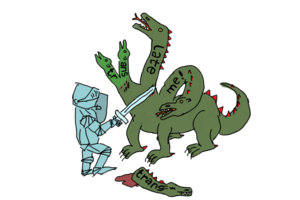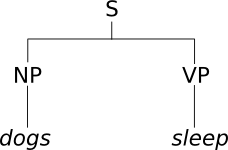Constituency Trees: Difference between revisions
No edit summary |
No edit summary |
||
| Line 27: | Line 27: | ||
Adj -> black | Adj -> black | ||
N -> cat | N -> cat | ||
When a natural language sentence is analyzed with a constituency grammar, we obtain a parse tree, such as the following: | |||
[[File:dogs-sleep.png|400px]] | |||
We can mend this grammar by dividing each nonterminal into two variants -- one for singular and one for plural. In general, linguistic phrases have many independent linguistic properties which would require us to split the nonterminals into an exponential number of variants. | We can mend this grammar by dividing each nonterminal into two variants -- one for singular and one for plural. In general, linguistic phrases have many independent linguistic properties which would require us to split the nonterminals into an exponential number of variants. | ||
== Syntax in Machine Translation == | == Syntax in Machine Translation == | ||
In MT, constitua | |||
== Synchronous Grammars for Translation == | == Synchronous Grammars for Translation == | ||
Revision as of 09:49, 6 August 2015
 | |
| Lecture video: |
web TODO Youtube |
|---|---|
Context Free Grammar
Grammars, generally, are a way of describing a potentially infinite set of strings (sentences) using a finite set of production rules. In a context-free grammar, production rules take the following form:
V → w
V is a non-terminal symbol (for natural languages, non-terminals usually correspond to phrases, such as NP for noun phrases) and w is a (non-empty) string of terminals (words) and nonterminals. It is known that CFGs cannot fully describe natural languages but for MT, they can serve as a very useful simplification.
One nonterminal symbol serves as the top-level nonterminal where the generation starts (or where analysis ends) -- for natural languages, we usually use the symbol S (sentence).
The following example grammar can generate (or analyze) sentences such as Dogs sleep (grammatical English) or The black cat sleep (ungrammatical).
S -> NP VP NP -> dogs VP -> sleep NP -> Det Adj N Det -> the Adj -> black N -> cat
When a natural language sentence is analyzed with a constituency grammar, we obtain a parse tree, such as the following:
We can mend this grammar by dividing each nonterminal into two variants -- one for singular and one for plural. In general, linguistic phrases have many independent linguistic properties which would require us to split the nonterminals into an exponential number of variants.
Syntax in Machine Translation
In MT, constitua
